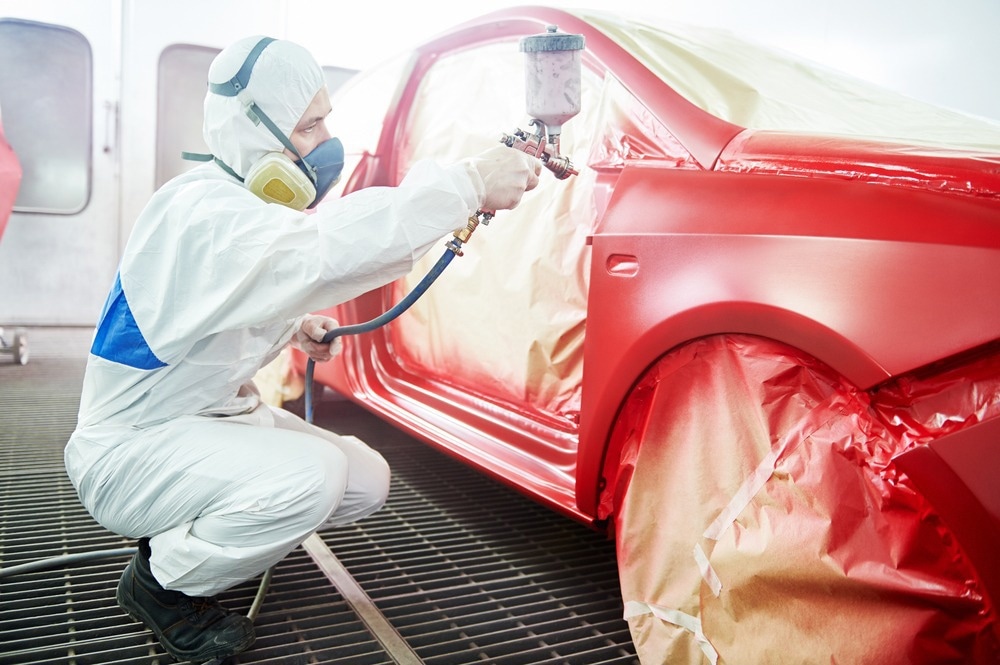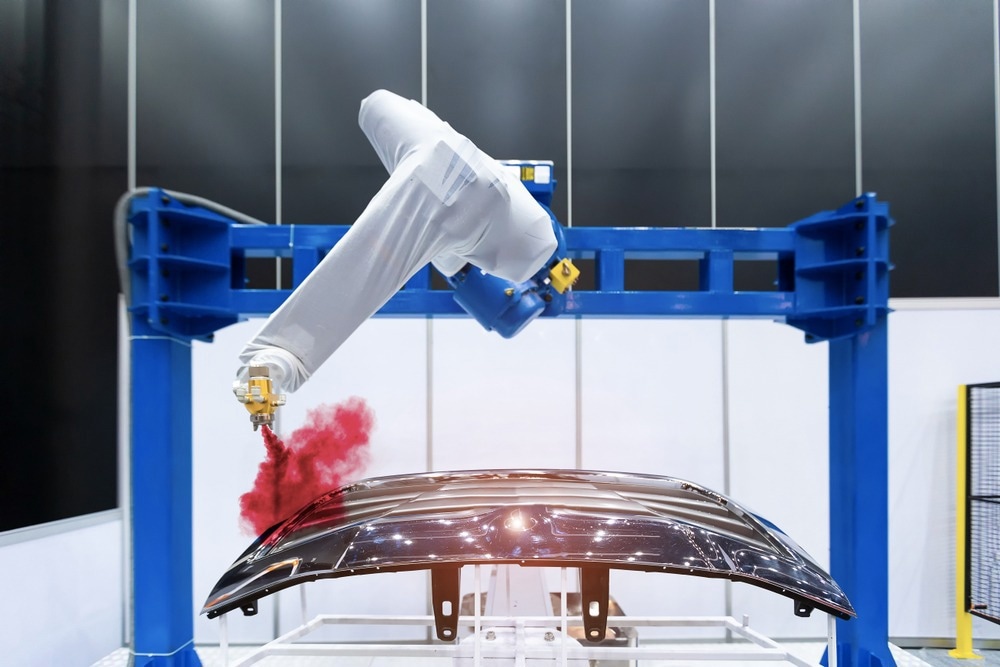This transition has brought major productivity, quality improvements, and environmental and economic benefits. As automotive production volumes grow globally, robotic painting and finishing will be essential for maximizing efficiency and customization capability.
Robotic painting and finishing emerged in the early 1980s in Germany at companies like Mercedes-Benz and BMW and were later adopted by other major automakers, including Volkswagen, Peugeot, and Fiat. However, initial enthusiasm declined by the late 1980s due to high costs and complexity, leading to a lack of new installations.
Recent years have seen a resurgence of interest in robotic painting, driven by the automotive industry's productivity and quality improvement efforts. Today's paint robots have shown substantial improvements in reliability, speed, accuracy, and flexibility compared to models from a decade ago.
Key advancements include the shift from hydraulic to electrically driven robots, a 50 percent increase in painting speed, improved path tracking accuracy (from ±25 mm to ±0.1 mm), greater precision in reaching programmed points, and enhanced motion capabilities, especially in tight spaces like engine compartments. Off-line simulation and programming using CAD models have become standard practices for achieving these improvements.

Image Credit: Dmitry Kalinovsky/Shutterstock.com
Articulated Arm Robots Dominate Modern Automotive Paint Shops
Most robots used in automotive plants are 6-axis articulated arm robots equipped with atomizing bells to spray paint. These are designed specifically for the painting and finishing environment, with explosion-proofing, easy-to-clean exteriors, and paint delivery systems integrated into the arm.
These robots can be floor, wall or ceiling mounted or attached to linear rails for increased range of motion. This flexibility allows optimal booth configurations for various vehicle sizes and styles.
Benefits of Robotic Painting and Finishing Processes
The most significant benefit of automotive paint robots is their ability to provide consistent and precise paint application, eliminating variations in thickness seen with human painters. Additionally, they can be programmed for accurate coating application, elevating the overall finish quality.
Robots enable air recirculation and reduce downdraft speeds, facilitating precise paint application on complex surfaces. Leading companies like FANUC, ABB, and Dürr offer advanced paint robots with specialized designs, including a full 360-degree range of motion arms and wrists to coat exposed and confined areas like door jambs and trunks.
Robots enhance operational safety through collision detection and prevention features and reduce worker exposure to hazardous chemicals. By controlling flow rates and air pressure, robots achieve uniform layers with minimal overspray and material waste. Robots are estimated to reduce paint usage by 0.5 liters per vehicle, resulting in substantial savings in hazardous waste and costs due to high production volumes.
Economically, automating painting and finishing operations increases productivity, reduces operating costs, and improves product quality, leading to higher customer satisfaction. It also enhances manufacturing flexibility by adapting to changes in vehicle models and improves worker ergonomics.
How is Robotics Transforming the Automotive Painting Process?
Reducing Workplace Footprint, Maximizing Efficiency: ABB's Compact Paint Station
ABB Robotics, a global industrial robot manufacturer and supplier, introduced the Compact Interior Paint Station in 2020, offering an efficient alternative for automotive manufacturers. This space-saving solution reduces the paint booth footprint by up to 33%, accommodating various vehicle types.
The compact interior paint station includes six IRB 5500-27 7-axis robots with an extended reach and improved atomizer angle to minimize overspray. This eliminates the need for linear tracks and additional equipment, making it ideal for retrofitting existing paint shops.
Jörg Reger, Head of Robotics and Automation for ABB Robotics, highlighted the cost and time-saving benefits of the Compact Interior Paint Station: "By removing the need for ancillary equipment, such as the linear track and additional ventilators, the Compact Interior Painting Station can help to significantly reduce the time and cost of setting up a paint booth," He added. "With its ability to fit into different booth configurations, and with fewer items that need to be installed and maintained, it presents an ideal solution for retrofitting existing paint shops."

Image Credit: FUN FUN PHOTO/Shutterstock.com
Waste Reduction Through Overspray-Free Paint Solutions
A recent trend in automotive painting, driven by the desire for greater versatility and waste reduction, involves overspray-free technologies.
ABB's PixelPaint robot enhances automotive painting speed and reduces waste by printing paint directly onto the target area, achieving 100% transfer efficiency. It allows for two-tone paint and individual designs in a single pass without masking, reducing downtime, improving productivity, and offering more customized paint options.
Dürr also offers a similar overspray-free robotic technology called EcoPaintJet, which applies paint without an atomizer, offering high-edge definition without overspray. Using three valves to regulate the paint supply and 50 capillary nozzles for parallel paint jets, this system facilitates quick color changes and adjustable paint path width.
Precision Painting with AI: Automated Inspection and Sanding Robots
BMW's Regensburg assembly plant has become the world's first automotive facility to employ a comprehensive digitalized and automated system for inspecting, processing, and marking painted vehicle surfaces during regular production.
In this approach, AI-controlled robots use deflectometry individually on each vehicle to detect paintwork variations. Then, cameras scan black and white striped patterns, identify deviations, and transmit data to the computer system.
"What is unique here is that the robots work on each body exactly where needed, because the tiny specks and bumps that can appear after the topcoat is applied and that we want to remove are in different spots on each vehicle," Stefan Auflitsch, Head of BMW Regensburg Production Paint Application and Finish Plant.
The collected data is used to program flexible robots that sand and polish the problem areas accordingly. This eliminates unnecessary rework and ensures optimal quality and process speed.
Automated vision inspection and sanding robots enhance the paint finish quality by replacing slow and inconsistent manual checks with reliable defect detection and targeted robot repairs.
Future Outlook for Automotive Painting and Coating Robots
Advancements in robotic painting and finishing technology, such as multi-axis robot arms, integration of inspection systems, and AI-based programming, promise to enhance efficiency and quality.
Automobile manufacturers are innovating in painting trends, partly driven by the electric vehicle market. This ongoing competition and market evolution will continue to drive progress in robotic painting and finishing for large-scale, high-quality, customizable vehicle production.
References and Further Reading
Diverseco. (2023) Painting Robots. [Online]. Available at: https://diverseco.com.au/robotics/robotics-applications/painting-robots/
Graser, S. (2023) Automated surface processing at BMW Group Plant Regensburg – trio of digital paint shop processes. [Online]. Available at: https://www.press.bmwgroup.com/global/article/detail/T0411621EN/automated-surface-processing-at-bmw-group-plant-regensburg-%E2%80%93-trio-of-digital-paint-shop-processes
Grohmann, U. (1996) Paint robots in the automotive industry–process and cost optimization. Industrial Robot: An International Journal, 23(5), pp. 11-16. doi.org/10.1108/01439919610130319
Moore, J. R. (2017) Automotive paint application. Protective Coatings: Film Formation and Properties, pp. 465-496. doi.org/10.1007/978-3-319-51627-1_21
Nicholas O'Donnell. (2020) ABB unmasks the future of customized automotive painting with PixelPaint. [Online]. Available at: https://new.abb.com/news/detail/67469/abb-unmasks-the-future-of-customized-automotive-painting-with-pixelpaint
Nicholas O'Donnell. (2020) ABB's Compact Interior Paint solution saves space, reducing paint booth costs and environmental impact. [Online]. Available at: https://new.abb.com/news/detail/70697/abbs-compact-interior-paint-solution-saves-space-reducing-paint-booth-costs-and-environmental-impact
Roth, K. (2020) Paint application with high edge definition – and absolutely no overspray. [Online]. Available at: https://www.durr.com/en/media/news/news-detail/view/paint-application-with-high-edge-definition-and-absolutely-no-overspray-79155
Shu, T., et al. (2018). Dynamic path tracking of industrial robots with high accuracy using photogrammetry sensor. IEEE/ASME Transactions on Mechatronics, 23(3), pp. 1159-1170. doi.org/10.1109/TMECH.2018.2821600
Disclaimer: The views expressed here are those of the author expressed in their private capacity and do not necessarily represent the views of AZoM.com Limited T/A AZoNetwork the owner and operator of this website. This disclaimer forms part of the Terms and conditions of use of this website.